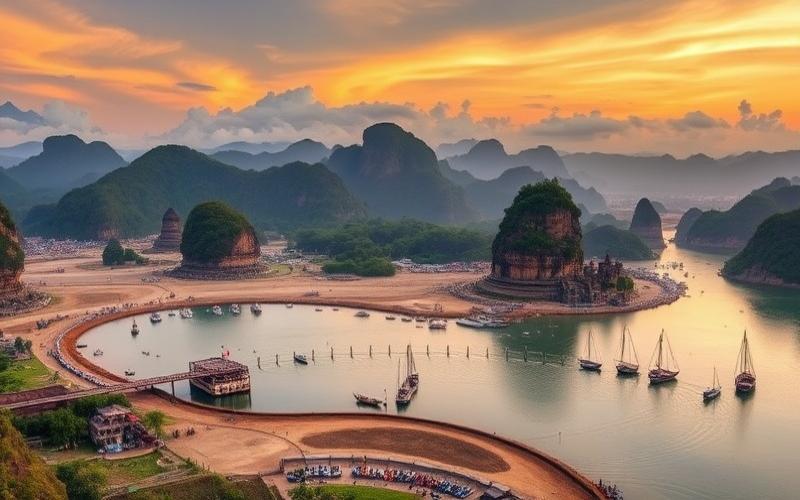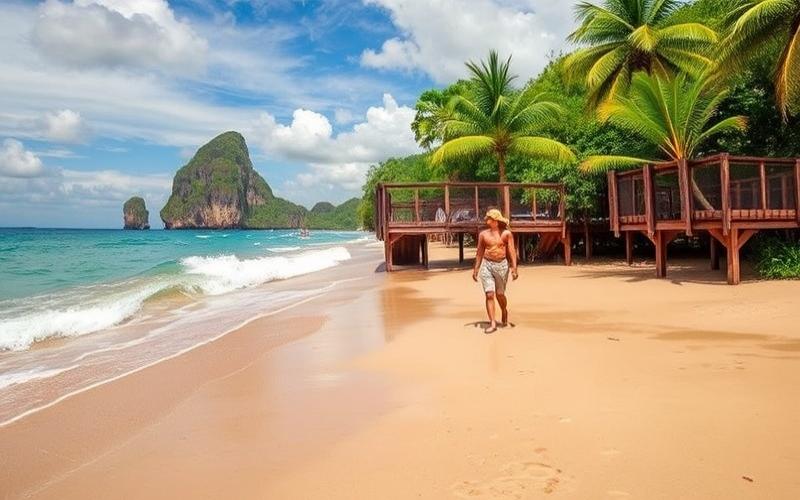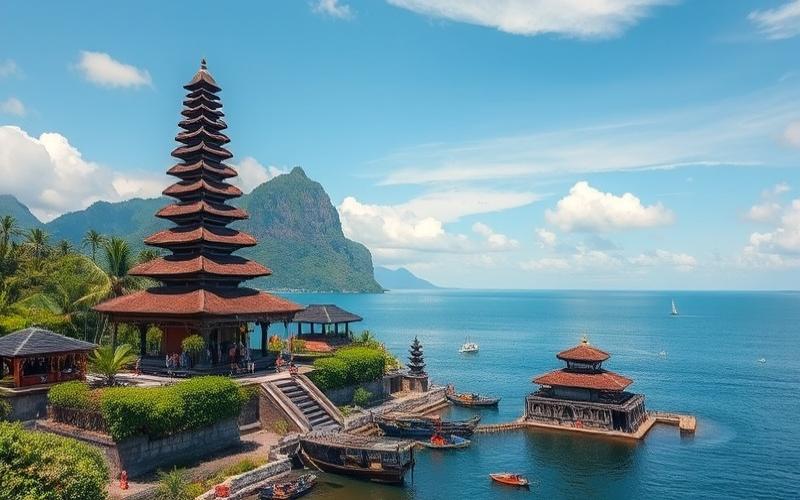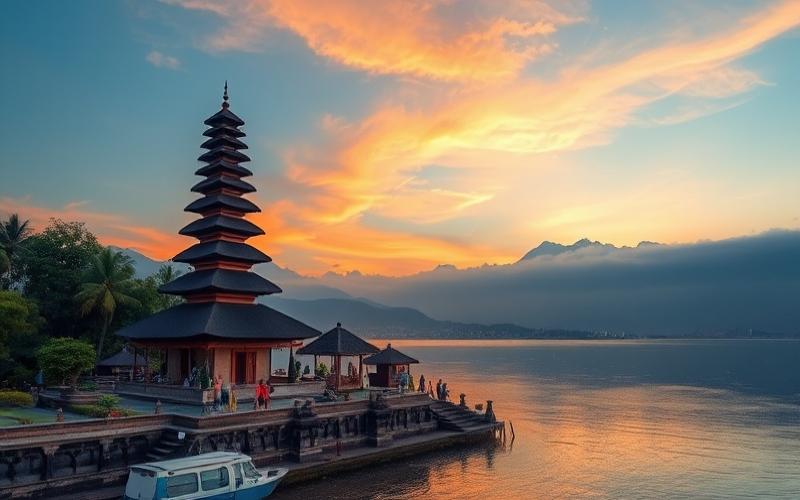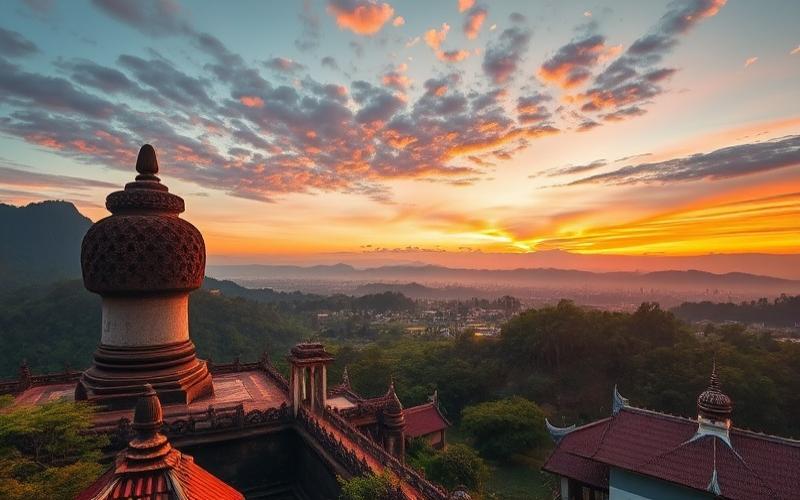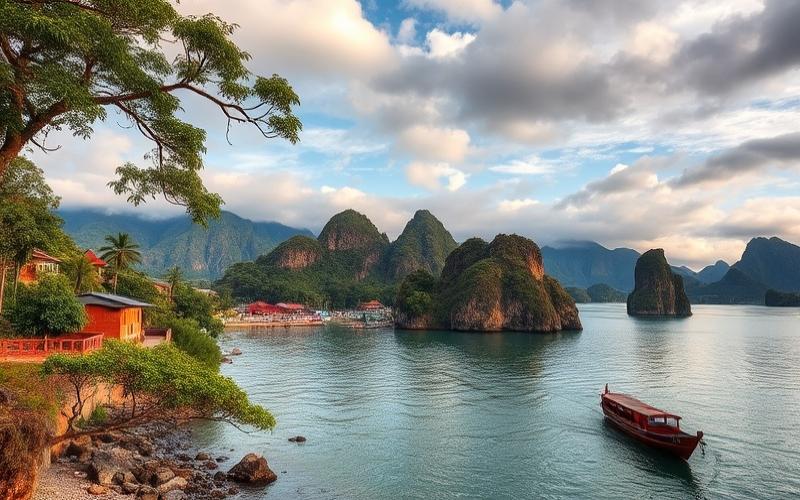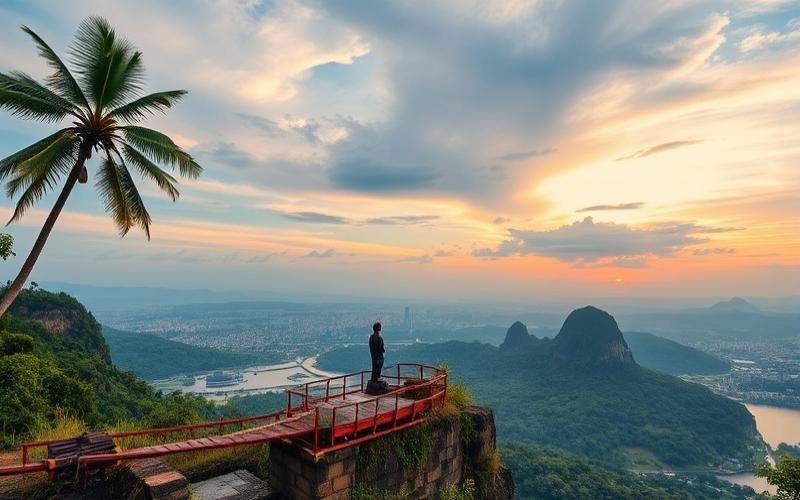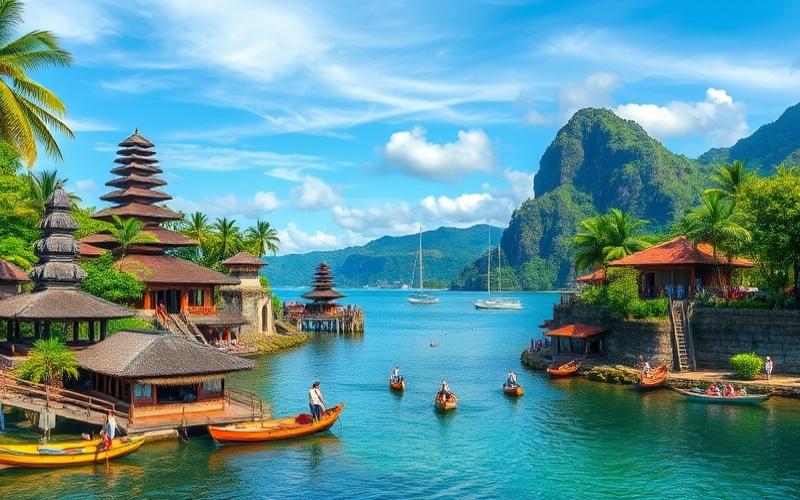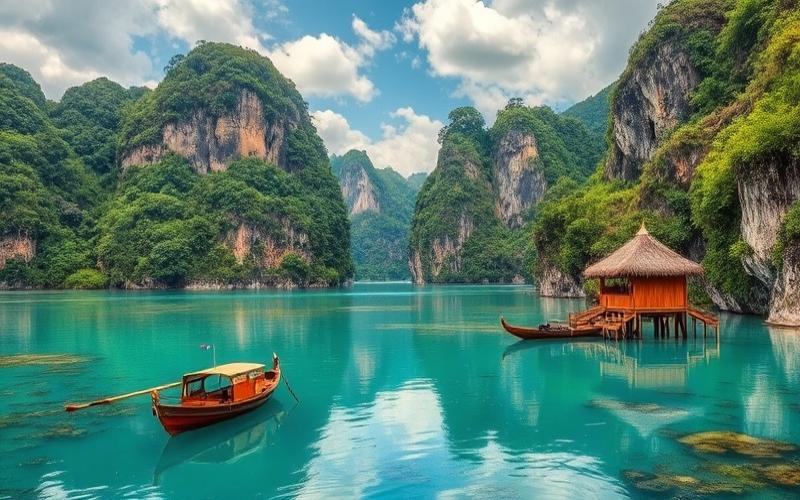
 Published on and written by Cyril Jarnias
Published on and written by Cyril Jarnias
Located at the strategic crossroads between Asia and Oceania, Indonesia has a rich and complex history that reflects its essential role in global trade and cultural diffusion for millennia.
From ancient times when the spice maritime routes saw their precious cargoes transit, to modern struggles for independence, each chapter of Indonesian history is marked by dynamic interactions among multiple ethnic groups, religions, and colonial powers.
With more than 17,000 islands scattered across tropical seas, this country holds astonishing human and natural diversity, which has uniquely shaped its society and history.
By exploring the epics of ancient kingdoms, Buddhist, Hindu, and Muslim influences, as well as contemporary challenges in forging a unified national identity, Indonesia’s history reveals a fascinating journey through time, blending tradition, resilience, and transformation.
The Fascinating Origins of Indonesia
The Indonesian archipelago results from extremely complex geology, shaped by the convergence of several major tectonic plates: the Australian Plate, the Sunda Plate, the Pacific Plate, and the Philippine Sea Plate. This dynamic has generated intense seismic and volcanic activity, giving rise to most of the major islands in the western archipelago (Sumatra, Java, Bali, Lesser Sunda Islands) over the last 2 to 3 million years. In the east, formations are older, with some deposits dating back to the Permian and Mesozoic eras. The subduction of the Indian Plate beneath the Sunda Plate notably created the western Indonesian volcanic arc, one of the most active regions on the globe.
Main Theories on Geological Formation:
- Multiple plate collisions and subduction (Australian, Sunda, Pacific, Philippine).
- Formation of volcanic arcs and emergence of islands since the Miocene.
- Western stratigraphy dominated by Cenozoic formations; eastern stratigraphy, older, ranging from Permian to Tertiary.
- Discovery of Mesozoic and Paleozoic fossils, attesting to the great geological age of certain areas.
First Traces of Human Settlement:
- The oldest Homo erectus fossils (“Java Man”) found in Indonesia date back approximately 1.5 million years.
- The first Homo sapiens are attested in the region at least 40,000 years ago.
- The eastern islands (Wallacea) were colonized early, likely by populations from mainland Asia via successive migrations.
Austronesian Migrations and Cultural Impact:
| Aspect | Description |
|---|---|
| Origin | Southern China and Taiwan, from the Neolithic (around 2000 BCE) |
| Main Vector | Mastery of navigation and outrigger canoes |
| Areas Affected | Coastal and island regions of Indonesia, Philippines, Melanesia, as far as Madagascar |
| Innovations | Rice cultivation, pottery, metallurgy, new languages |
| Cultural Impact | Spread of Austronesian languages, structuring of village societies, expansion of agriculture, basis of Indonesian cultural identity |
First Significant Civilizations of the Archipelago:
- Srivijaya (7th–13th century):
- Major center of maritime trade and Mahayana Buddhism, located in Sumatra.
- Strategic control of the Strait of Malacca.
- Cultural and religious influence across maritime Southeast Asia.
- Majapahit (13th–15th century):
- Hindu-Buddhist empire, based in eastern Java.
- Unification of vast territories, political, military, and cultural influence over the entire archipelago.
- Development of a centralized administration, literature in Old Javanese, and monumental art.
External Influences:
- India:
- Introduction of Hinduism and Buddhism from the early centuries CE.
- Adoption of political models, Indian scripts (Pallava, Kawi), religious iconography, and architecture (temples, stupas).
- Spread of Sanskrit literature and philosophical concepts.
- China:
- Ancient trade and diplomatic relations, attested from the 7th century.
- Influence on ceramics, agricultural techniques, and social organization.
- Contributions from Chinese Buddhism and Confucianism, especially from the 15th century with the arrival of Chinese communities.
Schematic Summary:
| Key Factor | Impact on the Indonesian Archipelago |
|---|---|
| Geology | Island diversity, volcanism, earthquakes, fertile soils |
| Human Settlement | Genetic and cultural diversity, pre-Austronesian heritage |
| Migrations | Languages, agriculture, navigation, social structures |
| Ancient Kingdoms | Trade, centralization, religious and artistic influence |
| External Influences | Religious syncretism, cultural exchanges, urban development |
Indonesian history is thus the result of a unique intertwining of geological phenomena, migratory waves, and multiple external influences, which have shaped the cultural and religious mosaic of the world’s largest archipelago.
Good to Know:
The Indonesian archipelago was born from active tectonic plates, attracting Austronesian migrations that enriched the local cultural fabric; the Srivijaya and Majapahit kingdoms testify to Indian and Chinese influence, integrating Buddhism and Hinduism into a unique cultural landscape. The first human migrations date back over 40,000 years, transforming the archipelago into a crossroads of civilizations.
The Archipelago Under Influence: Periods of Colonization
Over the centuries, the Indonesian archipelago experienced successive waves of colonization and foreign influences that profoundly marked its culture, economy, and politics.
Early Foreign Influences (3rd century – 15th century):
- Indian navigators and traders: Spread of Hinduism and Buddhism, emergence of Indianized kingdoms like Srivijaya, Sailendra, Majapahit. Introduction of Sanskrit writing, monumental architecture (e.g., Borobudur), and centralized political structures.
- Chinese contacts: Regular trade relations, diplomatic exchanges, importation of luxury goods and technologies.
- Arab merchants: Gradual introduction of Islam, creation of Muslim sultanates (late 15th century, notably in Java and Sumatra), development of maritime trade, and transformation of local social structures.
Arrival of European Powers:
| Power | Key Dates | Main Influence |
|---|---|---|
| Portuguese | From 1511 | Capture of Malacca, establishment of trading posts, spread of Christianity, but political influence limited to a few ports. |
| Dutch | 1596 (1st exped.) 1619 (Batavia) | Foundation of Batavia (Jakarta), gradual domination via the VOC, control of the spice trade, hegemony over the archipelago. |
| British | Late 18th – 1824 | Temporary presence during the Napoleonic Wars, return of the archipelago to the Dutch in 1824. |
The Impact of the Dutch East India Company (VOC) and Dutch Hegemony:
- The VOC, founded in 1602, became the main European actor, imposing a monopolistic trade system, exploiting local resources, and suppressing any indigenous or foreign competition.
- Batavia, the VOC’s capital, became the administrative, military, and economic center.
- Dutch domination extended to the entire archipelago in the 19th century, after the fall of the VOC and direct takeover by the Dutch state.
Colonial Administration and Social Impacts:
- Establishment of a centralized administrative system, introduction of Western law and modern bureaucracy.
- Transformation of land structures: exploitation of cash crops (coffee, sugar, tobacco), forced labor (cultuurstelsel).
- Emergence of a local elite (priyayi) collaborating with Dutch administrators.
- Tensions and resistance: wars (e.g., Aceh, Bali), popular uprisings, nationalist movements from the early 20th century.
Other European Powers:
The British temporarily occupied Java and other islands (1811-1816), introduced some administrative reforms and abolished slavery, but ceded the archipelago to the Dutch through the Treaty of London in 1824.
Consequences for Modern Indonesia:
- The cultural and religious diversity of the archipelago is explained by the layering of these Indian, Islamic, and then European influences.
- The reaction to colonial domination contributed to the emergence of an Indonesian national consciousness, the adoption of Bahasa Indonesia as a common language, and the formation of modern political parties.
- The colonial administration left a lasting institutional legacy, but also persistent social and economic inequalities.
Summary of Main Waves of Colonization and Foreign Influences:
- Indian and Chinese influences (3rd-15th century)
- Islamization by Arab merchants (14th-16th century)
- Portuguese colonization (16th century)
- Dutch hegemony via the VOC, then Dutch colonial administration (17th-20th century)
- Brief British interlude (early 19th century)
Modern Indonesia is the product of these multiple layers of influences, where resistance to colonization forged a powerful sense of national unity.
Good to Know:
The waves of colonization in Indonesia, marked by the arrival of Indian, Chinese, Arab navigators, and then Europeans, particularly the Portuguese and Dutch, transformed the archipelago, shaping its current culture, economy, and politics. The Dutch East India Company left a lasting imprint, consolidating a hegemony whose effects still resonate in modern Indonesia today.
From an Ancient Name to Present-Day Indonesia: A Historical Evolution
The archipelago now called Indonesia bore many names before adopting its modern identity. Europeans long referred to it as the East Indies, the Malay Archipelago, or Insulinde. Ancient local kingdoms, like Srivijaya (7th–13th century) and Majapahit (13th–16th century), did not use a name encompassing the entire archipelago, each political entity having its own name and identity.
| Ancient Name | Meaning / Origin | Period of Use |
|---|---|---|
| East Indies | European designation | 16th–20th centuries |
| Malay Archipelago | Geographic and ethnic term | 19th–20th centuries |
| Insulinde | “Islands of India” (Latin/Greek) | Introduced in 1860 |
| Indu-nesians | “Insular Indians” (English) | 1850 |
| Indonesia | “Indian Islands” (Greek) | Popularized late 19th century |
The term “Indonesia” is a 19th-century neologism, constructed from the Greek indos (“India”) and nêsos (“island”), meaning “Indian islands.” It appeared in 1850 in the writings of the English ethnologist George Earl and was adopted by his student James Richardson Logan. It only entered common usage in the early 20th century, particularly in nationalist and academic circles.
The history of the archipelago is marked by a succession of peoples and civilizations:
- Prehistory: Human presence attested by Homo erectus fossils in Java (2 million to 500,000 years ago), Homo floresiensis in Flores, and Homo sapiens (from 43,000 BCE).
- Megalithic and Neolithic periods: Development of agricultural, megalithic, and maritime societies.
- Indianized kingdoms (5th–15th centuries): Adoption of Sanskrit, Hinduism, and Buddhism. Major kingdoms:
- Srivijaya (Sumatra, 7th–13th centuries): Center of maritime trade between India and China.
- Majapahit (Java, 13th–16th centuries): Last great Hindu-Buddhist kingdom, influence over the entire archipelago.
- Islamization (13th–16th centuries): Gradual arrival of Islam through merchants, religious and cultural upheaval.
- European colonization:
- Portuguese (from 1511): First Europeans to establish themselves.
- Dutch (from 1602, complete domination in the 19th century): The archipelago officially became the “Dutch East Indies.”
| Peoples / Civilizations | Period of Influence | Marking Characteristics |
|---|---|---|
| Austronesians | From 2000 BCE | Mastery of navigation, spread of languages |
| Indians, Chinese | From the 5th century | Spread of Buddhism, Hinduism, trade |
| Arabs, Persians | From the 13th century | Introduction of Islam |
| Europeans (Port., Dutch) | 16th–20th centuries | Colonization, spice trade, exploitation |
The impact of Dutch colonization
was decisive in the formation of Indonesian identity. The Dutch unified the archipelago administratively and politically under the name Dutch East Indies (Nederlandsch Oost Indië). However, the use of the name “Indonesia” was initially rejected by colonial authorities, who preferred geographic or ethnic designations, until nationalist movements adopted it in the early 20th century.
Key Dates and Figures in the Transition to Indonesia
- 1908: Founding of the first nationalist organization, Budi Utomo.
- 1928: Youth Pledge (“Sumpah Pemuda”), affirmation of one homeland, one nation, one language: Indonesia.
- August 17, 1945: Sukarno and Mohammad Hatta proclaim the independence of the Republic of Indonesia.
- December 27, 1949: Official recognition of independence by the Netherlands.
The transition to the name “Indonesia” symbolizes the construction of a unified national identity, transcending ethnic, linguistic, and religious particularisms. This name change marks the passage from a mosaic of kingdoms, peoples, and colonies to a modern nation founded on diversity and the will for unity.
Essential Points on the Evolution of National Identity
- The notion of Indonesia was born from a political and cultural project aimed at overcoming divisions inherited from history.
- The adoption of the name “Indonesia” embodies the aspiration for independence, sovereignty, and unity.
- This process allowed the emergence of a common sense of belonging, while valuing the plurality of cultures and religions in the archipelago.
The shift from the name East Indies to Indonesia thus reflects a profound historical evolution, where the choice of a name becomes a founding act for the nation and its collective identity.
Good to Know:
Before becoming Indonesia, the archipelago was known by names such as Nusantara, influenced by Hindu-Buddhist civilizations, and later by Dutch rule which left a lasting impact; August 17, 1945 marks a decisive step with the official adoption of the name Indonesia symbolizing a new national era.
Disclaimer: The information provided on this website is for informational purposes only and does not constitute financial, legal, or professional advice. We encourage you to consult qualified experts before making any investment, real estate, or expatriation decisions. Although we strive to maintain up-to-date and accurate information, we do not guarantee the completeness, accuracy, or timeliness of the proposed content. As investment and expatriation involve risks, we disclaim any liability for potential losses or damages arising from the use of this site. Your use of this site confirms your acceptance of these terms and your understanding of the associated risks.


